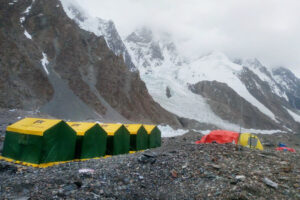Jamal Shahid interview
ISLAMABAD: “Impossible is a word that only exists in the dictionary,” said Simone Moro, who was part of the first-ever team that climbed Nanga Parbat in the winter.
Addressing a press conference at the Alpine Club of Pakistan on Thursday, Mr Moro shared his experiences of climbing the treacherous mountain with his two comrades.
Of the 14 highest mountains, which rise beyond 8,000 metres above sea level, only two remained that had not been summited in the winter: K2 and Nanga Parbat.
But on February 26, Pakistan’s Mohammad Ali Sadpara, Simone Moro from Italy and Spanish mountaineer Alex Txikon climbed the ‘Killer Mountain’, the ninth highest in the world. A fourth climber, Tamara Lunger, had to turn back just 100 metres from the top.
Italian, Spanish climbers hail Mohammad Ali Sadpara for being first to reach the summit
“Nanga Parbat is simply beautiful. It is the biggest mountain on the planet. It is so big that you can fit two K2s into it, you can even fit two of Mount Everest into it,” Simone said.
Simone, who has climbed four 8,000+ peaks in his career thus far, said that summiting a mountain in the winter was down to knowledge, experience and team spirit.
“No one knows Nanga Parbat better than Ali Sadpara and Alex Txikon, who made an attempt to climb it last year. We had a strategy this time,” Simone said, adding that he had a good feeling before setting off.
The team’s biggest strength, he said, was an understanding of the challenges it faced; patience and the ability to endure.
“Mountains don’t kill climbers. They die because of wrong decisions,” he added.
The four mountaineers had taken the Diamir Face route, one of three ways up the mountain. After three months of waiting, the climbers left Camp Four, located at a height of 7,100 metres at 6am on February 26.
Mohammad Ali Sadpara was the first to reach the summit at 3pm the same day. Moro and Txikon made it to the top at 3:37pm.
Last winter, Ali Sadpara and Txikon had taken a wrong turn, leading to a dead end on the mountain, and were forced to return just 300 metres from the top.
“It feels great to be the first Pakistani to summit a mountain higher than 8,000 metres in the winters. Over the years, I have lost friends and toes to frost bite. I cannot explain the joy I feel,” said Ali Sadpara, who has scaled Nanga Parbat twice in the summer.
“We learnt from our mistakes this year. The last 500 metres were the hardest because the slopes are rocky and steep,” said Alex Txikon, who has climbed 12 of the 14 highest peaks in the world.
He said he had not enjoyed any of the climbs as much as this one.
“I did not enjoy the final push because it was simply a lot of suffering. But now that I have accomplished it, it seems unbelievable,” Alex said from under his Chitrali cap.
Tamara Lunger, who climbed K2 and stopped 100 metres from the top of Nanga Parbat, was also at the conference.
“Climbing Nanga Parbat was my dream and my parents always encouraged me. But I had lost a lot of energy because I had thrown up. I knew that if I continued, I will be too exhausted to descend so I turned back,” Tamara said.
Responding to a question, Simone Moro said Pakistan has a lot more than five of the highest peaks to offer tourists.
“You have thousands of unclimbed mountains that adventurers dream of climbing. Pakistan is no more dangerous than America, Italy or Nepal and other countries,” Simone said.
He said Mohammad Ali Sadpara’s achievement was an testament of what Pakistanis could accomplish.
“We are proud that history has been written by a Pakistani,” Simone added.
Published in Dawn, March 4th, 2016





